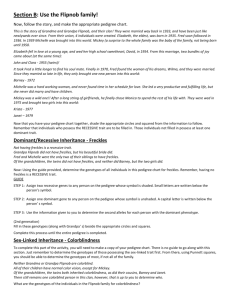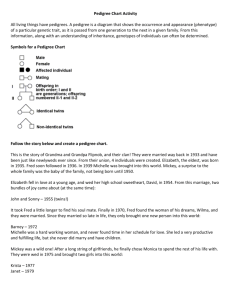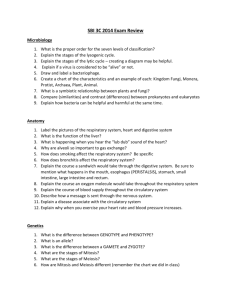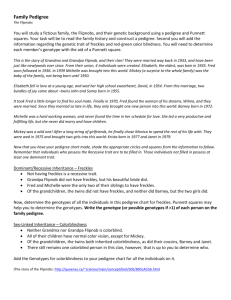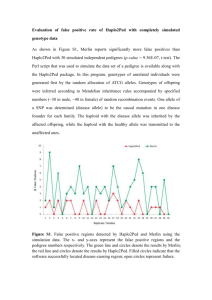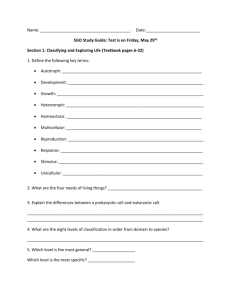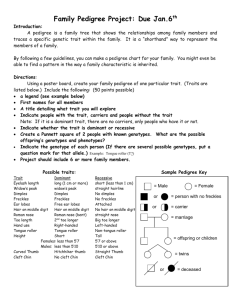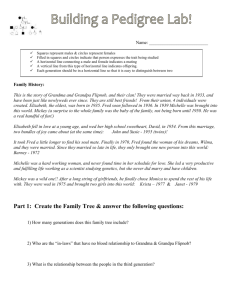3.3.3 How to Construct a Pedigree
advertisement
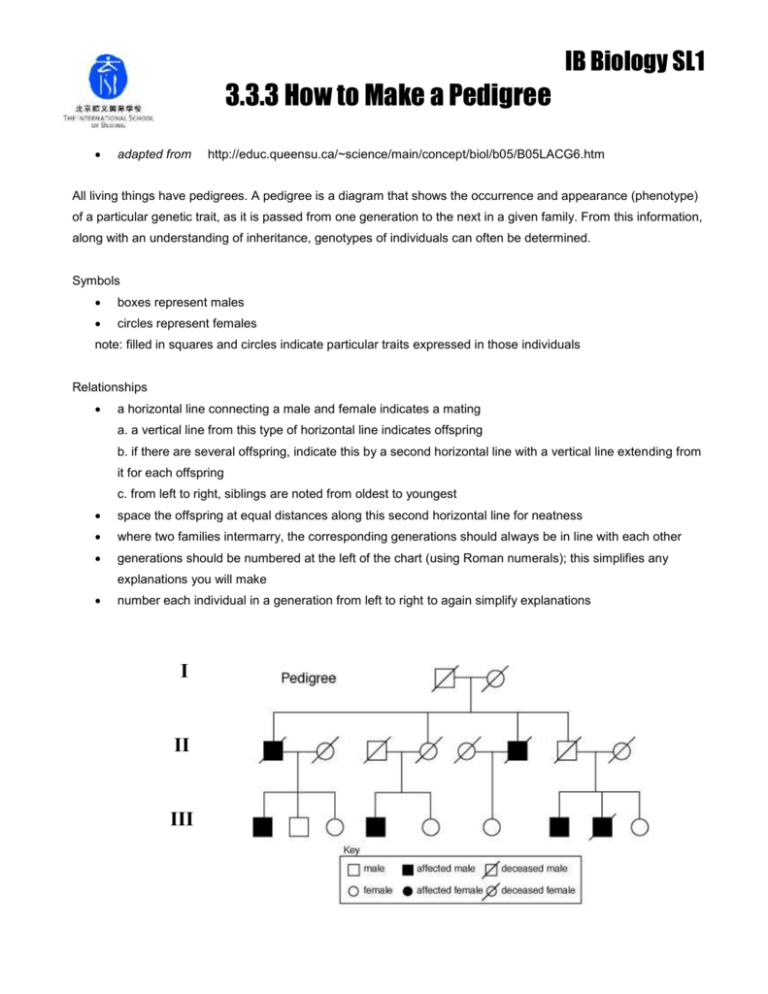
IB Biology SL1 3.3.3 How to Make a Pedigree adapted from http://educ.queensu.ca/~science/main/concept/biol/b05/B05LACG6.htm All living things have pedigrees. A pedigree is a diagram that shows the occurrence and appearance (phenotype) of a particular genetic trait, as it is passed from one generation to the next in a given family. From this information, along with an understanding of inheritance, genotypes of individuals can often be determined. Symbols boxes represent males circles represent females note: filled in squares and circles indicate particular traits expressed in those individuals Relationships a horizontal line connecting a male and female indicates a mating a. a vertical line from this type of horizontal line indicates offspring b. if there are several offspring, indicate this by a second horizontal line with a vertical line extending from it for each offspring c. from left to right, siblings are noted from oldest to youngest space the offspring at equal distances along this second horizontal line for neatness where two families intermarry, the corresponding generations should always be in line with each other generations should be numbered at the left of the chart (using Roman numerals); this simplifies any explanations you will make number each individual in a generation from left to right to again simplify explanations I II III IB Biology SL2 3.3.3 The Flipnob Family This is the story of Grandma and Grandpa Flipnob… and their clan! They were married way back in 1933, and have been just like newlyweds ever since. From their union, four individuals were created. Elizabeth, the eldest, was born in 1935. Fred soon followed in 1936. In 1939 Michelle was brought into this world. Mickey (a surprise to everyone) was the baby of the family, not being born until 1950. Elizabeth fell in love at a young age, and wed her high school sweetheart, David, in 1954. From this marriage, two bundles of joy came about (at the same time): John and Sonny - 1955 (twins) It took Fred a little longer to find his soul mate. Finally in 1970, Fred found the woman of his dreams, Wilma, and they were married. Since they married so late in life, they only brought one new person into this world: Barney - 1972 Michelle was a hard working woman, and never found time in her schedule for love. She led a very productive and fulfilling life, but she never did marry or have children. Mickey was a wild one!! After a long string of girlfriends, he finally chose Monica to spend the rest of his life with. They were wed in 1975 and brought two girls into this world: Krista - 1977 Janet - 1979 1. Complete a pedigree for the Flipnob family. 2. Using the freckle trait, shade the appropriate circles and squares based on the following information. Remember that only individuals who possess the RECESSIVE trait are to be filled in. Those individuals not filled in possess at least one dominant allele. Dominant Allele – F Freckles Recessive Allele – f no freckles Grandpa Flipnob did not have freckles, but his beautiful bride did. Fred and Michelle were the only two of their siblings to have freckles. Of the grandchildren, the twins did not have freckles, and neither did Barney, but the two girls did. 3. Determine the possible genotypes of all individuals in this pedigree chart for freckles. Pedigrees show the genetic history of a family in what is similar to a "genetic family tree". It shows the phenotypes of a particular genetic trait from one generation to the next in a family. Most of the time the genotypes of the individuals may be determined as well by using your understanding of inheritance. Can be useful in determining who is a carrier (heterozygote) for a genetic disease, such as: Autosomal recessive disorders: o Albinism: inability to produce melanin o Tay Sach's: cannot dispose of fatty molecules in nervous system, build up leads to mental degeneration and death o Cystic Fibrosis: recessive disorder on chromosome 7 causes build up of heavy mucous in lungs o Sickle-Celled Anemia: abnormal hemoglobin alters RBC shape and lowers the oxygen carrying capacity of blood Autosomal Dominant Disorders: o Huntington's Disease: adults lose muscle control, convulsions, nervous degeneration causes death, found on chromosome 4, thus Hh or HH will get the disease o Polydactyly: dominant disorder that causes extra fingers and toes Each generation is represented by a Roman Numeral, and each person in a generation is labeled with a number in the order in which they were born. Squares are males and circles are females. Usually a shaded or darkened symbol shows the condition that is being studied. All un-shaded symbols are individuals who have the dominant phenotype and at least on dominant allele. Carriers may be identified by symbols with lines through them.

